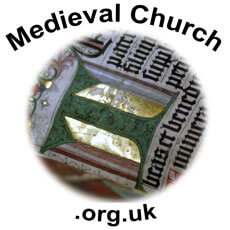The Carthari: Albigenses
Theology on the Web helps over 2.5 million people every year to find high quality theological resources that will help to equip them to serve God and to know Him better (2 Timothy 2:15). Like other websites that provide free services, it is dependent on donations to enable it to grow and develop and only 0.004% of visitors currently do so. If you would like to support this site, please use one of the options to the right of this message.
Synopsis
ALBIGENSES, a sect which from the beginning of the eleventh century spread rapidly and widely in Southern France, and maintained itself there till the middle of the thirteenth century; received its name from the city of Albi, Latin Albiga, the present capital of the department of Tarn, which was one of their principal seats. The name does not occur, however, until the time of the Albigensian crusade. Before that time the sect was spoken of as the Poblicants, or Publicani, probably a corruption of the name of the Paulicians, which the crusaders had brought back to Western Europe, or as the Bos Homes, Latin, Boni Homines, French, Bons Hommes, which name they themselves gave to those among them who reached the highest state of perfection, the perfecti.
Of the doctrines of the Albigenses nothing is known with certainty. They have left no writings, confessional, apologetical, or polemical; and the representations which Roman-Catholic writers, their bitter enemies, have given of them, are highly exaggerated. It is evident, however, that they formed a branch of that broad stream of sectarianism and heresy which arose far away in Asia from the contact between Christianity and the Oriental religions, and which, by crossing the Balkan Peninsula, reached Western Europe. The first outflow from this source were the Manichaeans, the next the Paulicians, the next the Cathari, who in the tenth and eleventh centuries were very strong in Bulgaria, Bosnia, and Dalmatia. Of the Cathari, the Bogomiles, Patoreni, Albigenses, etc., were only individual developmepts. In general they all held the same doctrines, dualism, docetism, etc.; the same moral tenets, an austere simplicity bordering on asceticism; the same organization, a division into two classes of credentes, or auditores, and perfecti; and the same policy, opposition to the Roman-Catholic Church. See the article CATHARI.
From Italy the movement reached Southern France in the beginning of the eleventh century; and here the soil was wonderfully well prepared for the new seed. The country was rich, flourishing, and independent; the people, gay, intellectual, and progressing; the Church, dull, stupid, and tyrannous; and the clergy, distinguished by nothing but superstition, ignorance, arbitrariness, violence, and vice. Under such circumstances the idea of a return to the purity and simplicity of the apostolical age could not fail to attract attention. The severe immoral demands made impression, because the example of the preachers corresponded to their words. The doctrine of an absolute and original dualism naturally recommends itself to the understanding as the easiest solution of many a knotty problem. No wonder, then, that the people deserted the Roman-Catholic priests, and crowded around the Bos Homes. In a short time the Albigenses had congregations, with schools and charitable institutions of their own. Then they drove away the Roman-Catholic priests from the churches, took possession of the buildings, and elected their own priests and bishops. Finally the lords of the laud, the great barons and counts, openly placed themselves at the head of the movement; and in 1167 the Albigenses held an Albigensian synod at Toulouse for the purpose of perfecting their organization. The Roman-Catholic Church, so far as it still could be said to exist in the country, had become an object of contempt and derision.
This state of affairs caused, of course, great alarm in Rome. As early as 1119 a council was convened at Toulouse; and the tenets of the Cathari, such as preached by the Bos Homes, were condemned. From time to time the condemnation was repeated by the councils of the Lateran (1139), of Rheims (1148), of Tours (1163), etc., but without any effect. Missions were sent out among the heretics. In 1147 St. Bernard of Clairveaux visited them; and his preaching was probably not altogether lost. In 1165 a disputation between the orthodox and the heretical bishops and priests was held at Lombers, near Albi; but no result was arrived at. In 1178 Cardinal Peter, with a great retinue of prelates and monks, tried, for the last time, persuasion; and in 1180 Cardinal Henry, for the first time, employed force. He preached a crusade against the Albigensian heretics. Troops were drawn together; some strong places were carried with the usual accompaniment of massacre and carnage; and then the case was again allowed to drag along, until at last Innocent III. succeeded in finishing it by employing measures which he is said to have repented bitterly of himself. In 1208 the papal legate, Pierre de Castelnau, was murdered; and the murder was ascribed to Count Raymond of Toulouse. A new crusade was preached, to be led by Arnold, Abbot of Citeaux, as papal legate, and Simon of Montfort, Earl of Leicester, as military chief; and behind this line stood time French king waiting for an opportunity to rob Count Raymond of his beautiful lands. The count humiliated himself as much as he possibly could: he paid a large sum into the papal treasury, was flagellated by the papal legate, and then took the cross against his own subjects. The first place which was taken was Beziers, a city of between twenty thousand and forty thousand inhabitants, and the capital of Count Roger, Rayniond’s nephew, who had openly espoused the cause of the heretics. When the general asked what to do with the inhabitants of the captured city, the papal legate answered, "Kill them all! God will know his own." In this manner the war was carried on for twenty years. Town after town was taken, pillaged, and burnt; of the inhabitants, the orthodox were chained together, and sent to the Mohammedan1 slave-markets, while the heretics were massacred and burnt. Nothing was left but a smoking waste. But, as the war went on, its purpose changed. Religious fanaticism had begun it: rapacity and ambition were going to end it. When Raymond was ready to hand over all his movable property to the pope, and all his land to the French king, peace was concluded in 1229; and, in order to purge the population, the Inquisition was established in Languedoc, and soon extinguished the sect.
1 An inaccurate, offensive and obsolete name for Muslims. It should not be used by modern writers.
C. Schmidt, "Albigenses," Philip Schaff, ed., A Religious Encyclopaedia or Dictionary of Biblical, Historical, Doctrinal, and Practical Theology, 3rd edn, Vol. 1. Toronto, New York & London: Funk & Wagnalls Company, 1894. pp.46-47. Footnote mine
Primary Sources
| Peter of les Vaux de Carney, The History of the Albigensian Crusade, W.A. & M.D. Sibly, translators. Woodbridge, 1983. | |
| J. Shirley, translator, The Song of the Cathar Wars. A History of the Albigensian Crusade, William of Tudela and an Anonymous Successor. Aldershot, 1996. | |
 W.A. Sibly & M.D. Sibly, The History of the Albigensian Crusade. The Boydell Press, 2000. Pbk.
ISBN: 0851158072. pp.379. W.A. Sibly & M.D. Sibly, The History of the Albigensian Crusade. The Boydell Press, 2000. Pbk.
ISBN: 0851158072. pp.379. |
Secondary Sources
Related Subjects
Albigenses | Patarenes
 |
|
 |
|
 |
Heresies | Alogi | Apollinarianism | Arianism | Docetism | Donatism | Gnosticism | Manicheaism | Marcion | Monarchianism | Montanism | Nestorianism | Pelagianism |





 Malcolm Barber, The Cathars: Dualist Heretics in
Languedoc in the High Middle Ages. The Medieval World. Longman, 2000. Pbk.
ISBN: 0582256615. pp.293.
Malcolm Barber, The Cathars: Dualist Heretics in
Languedoc in the High Middle Ages. The Medieval World. Longman, 2000. Pbk.
ISBN: 0582256615. pp.293. Sheila Bonde, Fortress Churches of Lanquedoc: Architecture, Religion and Conflict in the
High Middle Ages. Cambridge: Cambridge University Press, 1994. Hbk. ISBN:
0521450845. pp.270.
Sheila Bonde, Fortress Churches of Lanquedoc: Architecture, Religion and Conflict in the
High Middle Ages. Cambridge: Cambridge University Press, 1994. Hbk. ISBN:
0521450845. pp.270. Michael Costen, The Cathars and the Albigensian
Crusade. Manchester University Press, 1997. Pbk. ISBN: 0719043328.
pp.240.
Michael Costen, The Cathars and the Albigensian
Crusade. Manchester University Press, 1997. Pbk. ISBN: 0719043328.
pp.240. James B. Given, Inquisition
and Medieval Society: Power, Discipline, and Resistance in Languedoc.
Cornell University Press, 1997. Hbk. ISBN: 0801433584. pp.264.
James B. Given, Inquisition
and Medieval Society: Power, Discipline, and Resistance in Languedoc.
Cornell University Press, 1997. Hbk. ISBN: 0801433584. pp.264. Thomas F. Madden, A Concise
History of the Crusades. Rowman and Littlefield Publishers Inc., 2000. Hbk.
ISBN: 0847694291. pp.129-138.
Thomas F. Madden, A Concise
History of the Crusades. Rowman and Littlefield Publishers Inc., 2000. Hbk.
ISBN: 0847694291. pp.129-138. Steven Runciman, The
Medieval Manichee: A Study of the Christian Dualist Heresy. Cambridge:
Cambridge University Press, 1982. Pbk. ISBN: 0521289262. pp.224.
Steven Runciman, The
Medieval Manichee: A Study of the Christian Dualist Heresy. Cambridge:
Cambridge University Press, 1982. Pbk. ISBN: 0521289262. pp.224. Joseph R. Strayer, The
Albigensian Crusades. University of Michigan Press, 1992. Pbk. ISBN:
0472064762. pp.283.
Joseph R. Strayer, The
Albigensian Crusades. University of Michigan Press, 1992. Pbk. ISBN:
0472064762. pp.283.


